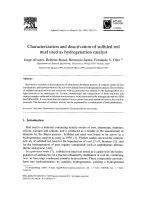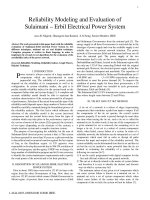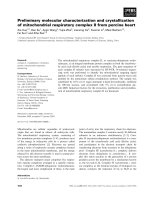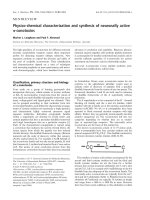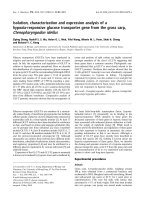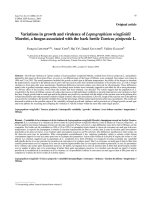Isolation, characterization and evaluation of pink pigmented facultative methylotrophs (PPFMS) associated with paddy
Bạn đang xem bản rút gọn của tài liệu. Xem và tải ngay bản đầy đủ của tài liệu tại đây (635.14 KB, 24 trang )
Int.J.Curr.Microbiol.App.Sci (2018) 7(7): 2187-2210
International Journal of Current Microbiology and Applied Sciences
ISSN: 2319-7706 Volume 7 Number 07 (2018)
Journal homepage:
Original Research Article
/>
Isolation, Characterization and Evaluation of Pink Pigmented Facultative
Methylotrophs (PPFMS) Associated with Paddy
N.S. Nysanth1*, K.S. Meenakumari1, Elizabeth K. Syriac2 and P. Subha1
1
Department of Agricultural Microbiology, College of Agriculture, Vellayani-695522,
Thiruvananthapuram, Kerala Agricultural University, Kerala, India
2
Department of Agronomy, College of Agriculture, Vellayani-695522, Thiruvananthapuram,
Kerala Agricultural University, Kerala, India
*Corresponding author
ABSTRACT
Keywords
Pink pigmented
facultative
methylotrophs,
Phyllosphere,
paddy, Kerala
Article Info
Accepted:
17 June 2018
Available Online:
10 July 2018
Methylobacterium spp. are a group of bacteria known as pink-pigmented facultative methylotrophs
(PPFMs) capable of growing on single carbon compounds such as formate, formaldehyde, and
methanol as well as on a variety of multicarbon compounds having no carbon-carbon bonds. They
are distributed ubiquitously in the plant phyllosphere and rhizosphere and have been isolated from
many species of plants. Methylotrophs are known to play an important role in increasing crop yield
and soil fertility. Methylobacterium is able to produce indole-3-acetic acid (IAA), suggesting that
inoculation of PPFM bacteria could increase plant IAA concentrations and promote plant growth.
The present programme envisages isolation, characterization and evaluation of Pink Pigmented
Facultative Methylotrophs (PPFMs) associated with paddy. As part of the study conducted in the
Department of Agricultural Microbiology, College of Agriculture, Vellayani, Thiruvananthapuram,
Kerala, during 2015-2017, Pink Pigmented Facultative Methylotrophs (PPFMs) were isolated from
the phyllosphere of paddy collected from different agro climatic conditions of Kerala by leaf imprint
method using Ammonium Mineral Salt (AMS) agar media supplemented with 0.5% methanol and
cycloheximide. In all, 46 isolates were obtained. The isolates were obtained from different districts
of Kerala such as Thiruvananthapuram, Alappuzha and Palakkad including Attappadi hill tract. They
were tentatively identified as PPFMs based on the characteristic pink pigmented colonies on AMS
agar media with methanol as sole source of carbon and energy. All the 47 PPFM isolates including
reference culture were found to produce IAA under in vitro conditions. However, it showed wide
variations ranging from 6.74 to 33.35 µg mL-1 of culture filtrate. Maximum IAA production of
33.35µg mL-1 of culture was recorded by PPFM35. Paddy seeds [var. Jyothi (Ptb-39)] treated with
PPFMs improved seed germination, biomass and seedling vigor index of paddy seedlings. Maximum
germination percentage of 100 was recorded in seeds treated with PPFM35. The isolate PPFM22
treated seedlings recorded the highest seedling vigour index of 4756.36 whereas PPFM35 recorded
seedling vigour index of 4250.00 over the control (3037.91). The root shoot ratio of seedlings
showed significant increase when seeds were treated with PPFM isolates. Maximum root shoot ratio
of 0.62 was observed when seeds were treated with PPFM26 and PPFM35 compared to control
(0.33). The isolate PPFM35 was adjudged as superior isolate based on indole-3-acetic acid (IAA)
production, maximum germination percentage, seedling vigour index and root shoot ratio. This
isolate was identified as Methylobacterium populi based on morphological, biochemical and
molecular characteristics.
2187
Int.J.Curr.Microbiol.App.Sci (2018) 7(7): 2187-2210
Introduction
The living space on the leaf surface, known as
the phyllosphere, harbours a wide variety of
organisms having beneficial, harmful or
neutral effects on the plant. The interaction
between such microorganisms and higher
plants affect the physiological activities of the
plant.
Pink
pigmented
facultative
methylotrophs (PPFMs) of the genus
Methylobacterium are commonly found in
association with plants. It is hypothesized that
they potentially dominate the phyllosphere
bacterial population. The degree of the plant
Methylobacterium association varies from
strong, or symbiotic to loose, or epiphytic; a
range that also includes the intermediate
endophytic association (Lacava et al., 2004).
The Methylobacterium spp. is characterized by
a distinctive pink pigmentation which is due to
the presence of carotenoid pigment
(Jyothilaxmi et al., 2012).
PPFMs
are
aerobic,
Gram-negative,
methylotrophic rod shaped bacteria, capable of
growing on a wide range of multicarbon
substrates and also on single carbon
compounds such as formate, formaldehyde
and methanol as their sole carbon and energy
source. It was assumed that significant
quantity of methanol is emitted from the plant
parts as a by-product of pectin metabolism
during cell wall synthesis (McDonald and
Fall, 1993; Nemecek- Marshall et al.,
1995).Numerous species and strains of
Methylobacterium have been isolated from
plants (Knief et al., 2010). PPFMs have been
isolated from more than 100 species of plants
ranging from liverworts and mosses to
angiosperms and gymnosperms (Corpe and
Basile, 1982). They are isolated on a methanol
based mineral medium, Ammonium Mineral
Salt (AMS) agar medium supplemented with
0.5% of methanol and cycloheximide at 100
mg L-1 (to inhibit fungal growth) by leaf
impression method.
Many reports suggest that PPFMs can act as
potential agents as plant growth promoters and
also help in surviving plants from pathogenic
attack (Madhayan et al., 2004). They have
been reported to produce plant growth
regulators like zeatin and related cytokinins
and auxins, which have significant effect on
seed germination and seedling growth.
Production of gibberellic acid (GA) by
Methylobacteria has already been reported
(Thangamani, 2005; Radha, 2007; Jones,
2010). Additionally, Methylobacterium have
been reported for the production of urease
enzyme (Holland and Polacco 1992), vitamin
B12 production (Basile et al., 1985), nitrogen
fixation and nodule formation (Raja et al.,
2006), phosphate solubilization (Jones, 2007),
synthesis of siderophores (Simionato et al.,
2006) and for the existence and prevalence of
ACC deaminase enzyme (Madhaiyan et al.,
2006). The first report on the production of
IAA in significant amount by methylotrophs
was by Ivanova et al. (2001) who detected
various indole compounds in the culture
liquids of 37 methylotrophic bacteria
belonging to different taxa and different
strains of Methylobacterium. Auxins produced
by theses strains were found to range between
3-100 µg mL-1. Omer et al., (2004)
unambiguously
confirmed
by
high
performance liquid chromatography in
combination with nuclear magnetic resonance
chromatography (NMR) that PPFM produced
plant hormone IAA. Thangamani and
Sundaram (2005) and Radha (2007) have
documented production of IAA by PPFM
ranging from 3.44 µg mL-1 to 25.51 µg mL-1
and 9.04 µg mL-1 to 28.15 µg mL-1
respectively. Madhaiyan et al., (2004)
observed higher photosynthetic activity in rice
cultivar Co-47 that received Methylobacterium
and attributed the effect due to enhancement
of chlorophyll concentration, maleic acid
content and increased number of stomata.
Several workers reported growth promotional
ability of PPFMs in several crops including
2188
Int.J.Curr.Microbiol.App.Sci (2018) 7(7): 2187-2210
cotton (Madhaiyan et al., 2005), rice
(Senthilkumar, 2003), groundnut (Reddy et
al., 2002), tomato (Thangamani and
Sundaram, 2005), soybean, blackgram and
sugarcane (Madhaiyan et. al., 2005).
Tamil Nadu Agricultural University was taken
as reference culture.
Considering the importance of PPFM as plant
growth promoting bacteria, an attempt was
made to isolate, characterize and to select
efficient PPFM strains from paddy based on
indole-3-acetic acid (IAA) production and
effect on paddy seed germination and seedling
growth.
PPFMs obtained by leaf imprint technique
were purified by the streak plate method and
well isolated colonies on the plates were
preserved on Peptone Glycerol Agar
(enrichment medium) slants at 4°C in a
refrigerator for further use.
Purification of Pink Pigmented Facultative
Methylotrophs (PPFMs).
Estimation of indole acetic acid production
by the different isolates obtained
Materials and Methods
Collection of leaf samples
The leaf samples of paddy were collected
from different agro climatic conditions of
Kerala. The samples were brought to the
laboratory in sterile polythene bags and stored
at 40C.
Isolation of pink pigmented facultative
methylotrophs (PPFMs)
Ammonium Mineral Salts (AMS) medium
(Whittenburry et al., 1970) is a selective
medium for isolation of methylotrophs. The
AMS medium was sterilized by autoclaving at
121°C for 15 min and cooled to 45°C. Filter
sterilized vitamin solution (Colby and Zatman,
1973) along with 0.5 per cent (v/v) methanol
was added after sterilization and before
pouring media on to petriplates. The pH of the
medium was adjusted to pH 7.0.
On the solidified AMS agar medium upper
and lower surface of leaf samples were placed
separately, in such a way as to make
impression of it. Then the leaves were lifted
away and plates were incubated at 300C for 7
days (Corpe, 1985). Based on characteristic
pink pigmentation of colonies they were
tentatively identified as PPFMs. The isolate
obtained from the commercial product of
Indole Acetic Acid was estimated as per the
procedure described by Gordon and Weber
(1951).
100 ml of AMS broth supplemented with 0.5
per cent methanol and cycloheximide was
prepared in 250 ml flasks. To this medium, 0.1
per cent tryptophan was added. Using sterile
technique, the medium was inoculated with
one ml of PPFM inoculum (107 cfu/ ml).
Flasks were kept for incubation at 300C for 7
days. After incubation, culture was
centrifuged at 10000 rpm for 10 minutes. To
the 10 ml of culture supernatant 2 ml of the
Salkowski reagent was added. Incubated at
room temperature for 25 minutes and then
read at OD530.
Using the standard curve for IAA, the amount
of IAA was calculated.
Effect of isolates of PPFM on paddy seed
germination
Seeds of variety Jyothi (Ptb-39) were surface
sterilized before treatment with the bacterial
suspension. The seeds were first washed with
sterile distilled water twice and then treated
with 70% ethanol for 1 min. This was
followed by treatment with 2% sodium
hypochlorite solution for 30 seconds. Finally,
2189
Int.J.Curr.Microbiol.App.Sci (2018) 7(7): 2187-2210
the treated seeds were thoroughly rinsed for
more than five times with sterile distilled
water. Surface sterilized seeds were soaked
overnight in 1 per cent of 7 days old liquid
culture (107 cfu/ ml) of the respective isolates.
After decanting the liquid culture, the dried
seeds were placed on filter paper in a petri
dish. Plates were incubated at 300 C for 72 hrs.
The untreated seeds were kept as control. The
germination percent was calculated after 72
hrs. After taking the number of germinated
seeds, percentage seed germination was
calculated using the formula,
Seed germination (%) =
Number of germinated seeds
× 100
Total number of seeds
Effect of isolates of PPFM on paddy
seedling growth
To calculate the effect of PPFM inoculation
on seedling vigor index of paddy, the seeds
were surface sterilized with 70% alcohol and
0.1% mercuric chloride, which was followed
by a series of washings with sterile distilled
water. Surface sterilized seeds were soaked
overnight in 1 per cent of 7 days old liquid
culture ((107 cfu/ ml) of the respective isolates
and sown in plastic pots filled with wetland
soil.
The untreated seeds were taken as control.
Seedling vigour index was calculated using
the formula,
Seedling Vigour Index = Germination Percent
x (Shoot length + Root length) (Baki and
Anderson, 1973).
After taking the dry weight of shoot and root
(g), Root Shoot ratio was calculated using the
formula,
Root Shoot Ratio =
Dry weight of root (g)
× 100
Dry weight of shoot (g)
Morphological, biochemical and molecular
characterization of isolates of PPFM
Morphological tests viz., cell shape, gram
reaction and motility were carried out to
characterize the tentatively identified PPFM
isolate. Biochemical characterization of
selected bacterial isolate were done by
performing various biochemical tests and
carbohydrate utilization tests by using
readymade Himedia© kits (HiCarboTM, Part A,
Band C, Hi25TM Enterobacteriaceae). Colour
change observed on the biochemical amended
media of the kit after spot inoculating culture
suspensions of selected isolates followed by
incubation for 72 h indicated the reaction with
respect to different biochemicals or
carbohydrates as positive or negative. The
results of biochemical tests were utilized to
arrive at a tentative genus level identification
of isolate. Bergey's manual of determinative of
bacteriology was used as a reference to
identify the isolate. Molecular characterization
of selected isolate was done by 16S rRNA
cataloging using universal primers.
Results and Discussion
The
pink
pigmented
facultative
methylobacteria (PPFM) were isolated from
the phyllosphere of paddy, collected from
different locations of Kerala. Isolations were
made following leaf imprint method using
Ammonium Mineral Salt (AMS) agar media
supplemented with 0.5% methanol and
cycloheximide (Lindstrom and Chistoserdova,
2002). Forty six isolates were obtained from
different locations and allotted code numbers
for each of the isolate. They were tentatively
identified as PPFMs based on the
characteristic pink pigmented colonies on
2190
Int.J.Curr.Microbiol.App.Sci (2018) 7(7): 2187-2210
AMS agar media with methanol as sole source
of carbon and energy (Plate 1and Plate 2). The
isolate obtained from the commercial product
of Tamil Nadu Agricultural University was
taken as reference culture.
The first report on the production of IAA in
significant amount by methylotrophs was by
Ivanova et al. (2001) who detected various
indole compounds in the culture liquids of 37
methylotrophic bacteria belonging to different
taxa
and
different
strains
of
Methylobacterium. Auxins produced by these
strains were found to range between 3-100 µg
mL-1. Omer et al., (2004) unambiguously
confirmed by high performance liquid
chromatography in combination with nuclear
magnetic resonance chromatography (NMR)
that PPFM produced plant hormone IAA.
Thangamani and Sundaram (2005) and Radha
(2007) have documented production of IAA
by PPFM ranging from 3.44 µg mL-1 to 25.51
µg mL-1 and 9.04 µg mL-1 to 28.15 µg mL-1
respectively. Methylobacterium is able to
produce IAA, suggesting that inoculation of
these bacteria could increase plant IAA
concentrations and promote plant growth (Lee
et al., 2006). The presence of IAA was
reported in supernatants of PPFM cultures
(Omer et al., 2004). There are numerous
reports available on indole-3-acetic acid (IAA)
production by PPFMs (Omer et al., 2004;
Anitha, 2010). In the present investigation, all
the 47 PPFM isolates were found to produce
IAA under in vitro conditions. However, it
showed wide variations ranging from 6.74 to
33.35 µg mL-1 of culture filtrate. Maximum
IAA production of 33.35 µg mL-1of culture
was recorded by PPFM35. The reference
culture produced 18.01 µg mL-1 of IAA (Table
1).
PPFMs have been reported to influence seed
germination and seedling growth by producing
plant growth regulators like zeatin and related
cytokinins and auxins. Seeds treated with the
methylotrophic strains
improved seed
germination, seedling vigor index (SVI) and
biomass of rice seedlings. The methylotrophic
population in the treated seedlings increased in
the vegetative stages when compared to
seeding stages. Treated seedlings showed a
higher accumulation of plant hormones viz
trans-zeatin riboside, isopentenyladenosine,
and indole-3-acetic acid than untreated
seedlings (Lee et al., 2006). Based on these
findings, effect of PPFM isolates on paddy
seed germination and seedling growth was
tested and the results revealed that the
germination percentage of inoculated seeds
showed a significant increase compared to
uninoculated control. Maximum germination
percentage of 100 was recorded in seeds
treated with PPFM35. This treatment was
found to be significantly superior to the
uninoculated control which recorded a
germination percentage of 86 per cent (Table
2).
The present investigation conclusively proved
that, PPFM inoculation in paddy seeds had
significant effect on biomass and seedling
vigor index (Plate 3). Observations on shoot
length and root length of PPFM isolates
inoculated seeds, after 14 days of sowing
showed a significant increase compared to
uninoculated control. Inoculation with PPFM6
recorded the maximum shoot length of 26.38
cm and was found to be significantly superior
to the uninoculated control which recorded a
shoot length of 17.84 cm. The reference
culture treated seedlings recorded a shoot
length of 23.03 cm. Maximum root length of
24.20 cm was obtained in seeds treated with
PPFM22 and this treatment was significantly
superior to the uninoculated control and
reference strain which recorded a root length
of 17.50 and 18.90 cm respectively. Paddy
seeds treated with PPFM22 recorded the
highest seedling vigour index of 4756.36,
whereas, PPFM35 recorded seedling vigour
index of 4250.00 and this was significantly
2191
Int.J.Curr.Microbiol.App.Sci (2018) 7(7): 2187-2210
superior compared to the control which
recorded a vigour index of 3037.91. The
reference culture recorded a seedling vigour
index of 3943.45 (Table 3)
Significant increase in seedling shoot fresh
weight, root fresh weight, shoot dry weight,
root dry weight and root shoot ratio compared
to control was observed when seeds were
treated with PPFM isolates. In the present
investigation, PPFM26 and PPFM35 strains
gave the best performance of seedling root
shoot ratio and increased significantly with
value of 0.62. These treatments showed 87.88
per cent increase in root shoot ratio over
uninoculated control (Table 4 and 5).
The isolate PPFM35 was adjudged as superior
isolate based on indole-3-acetic acid (IAA)
production,
maximum
germination
percentage, seedling vigour index and root
shoot ratio of paddy seedlings. This selected
isolate
was
characterized
based
on
morphological, biochemical and molecular
characteristics.
Microscopic studies revealed that the PPFM
isolates were rod shaped, motile, gram
negative and produced poly β-hydroxy
butyrate granules (Green and Bousifield,
1982). In the present investigation, the
superior isolate selected was subjected to
morphological characterization. The results
revealed that the isolate was rod shaped,
stained Gram negative and exhibited motility
(Plate 4). The expression of pink pigmentation
with varied level of intensity in PPFM
indicates the presence of carotenoids (Fasim,
2003) which is known to protect these bacteria
from intense light and UV radiation (Liu et al.,
1993). In the present study, medium pink
coloured colonies of PPFM35 were observed
after one week of incubation (Table 6).
All isolates were aerobes producing catalase
and oxidase as already demonstrated by Bellin
and Spain (1976) and positive for urease test
and indole production (Thangamani, 2005).
However, hydrolysis of casein, starch,
cellulose degradation, MR and VP test and
nitrate reduction test was not recorded in any
of the isolates.
In the present investigation, for further
characterization, the isolate PPFM35 was
subjected to a series of biochemical tests
(Table 7).
The methylotrophic bacteria having capability
to grow on different single carbon compounds
as sole source of carbon and energy, can also
grow on wide range of multi carbon growth
substrates
making
them
facultatively
methylotrophic. The selected isolate was
tested for the utilization of the 29 different
carbon compounds. Using the results of
various biochemical tests, a tentative genus
level identification was done. Bergey's manual
of determinative of bacteriology was used as a
reference to identify the isolate and the isolate
PPFM35 was identified to belong to genus
Methylobacterium. The results are presented
in Table 8.
The present investigation demonstrated that it
is possible to distinguish and classify the
methylotrophic bacteria using 16S rRNA
sequence analysis. Our results also indicated
that phylogenetic relationships based on 16S
rRNA sequences reflect the classical
taxonomic classification systems based on
phenotypic characteristics for methylotrophs.
Thus,
16S rRNA sequence analysis
could be a useful tool for detailed
classification of methylotrophs. 16S rRNA
gene phylogenetic analysis performed clearly
showed the position of the isolate within the
genus Methylobacterium. The 16S rRNA gene
sequencing analysis showed 100% homology
with that of Methylobacterium populi in the
existing database of National Center of
Bioinformatics.
2192
Int.J.Curr.Microbiol.App.Sci (2018) 7(7): 2187-2210
Table.1 Indole-acetic acid (IAA) production by the PPFM isolates
Sl. No.
1
2
3
4
5
6
7
8
9
10
11
12
13
14
15
16
17
18
19
20
21
22
23
24
25
26
Isolate
code No.
PPFM1
PPFM2
PPFM3
PPFM4
PPFM5
PPFM6
PPFM7
PPFM8
PPFM9
PPFM10
PPFM11
PPFM12
PPFM13
PPFM14
PPFM15
PPFM16
PPFM17
PPFM18
PPFM19
PPFM20
PPFM21
PPFM22
PPFM23
PPFM24
PPFM25
PPFM26
2193
IAA
(µg mL-1)*
7.12
19.52
25.67
19.82
11.09
15.77
19.44
16.24
17.40
9.33
22.60
8.09
7.28
8.26
10.47
9.78
9.55
6.74
19.67
29.19
22.74
16.55
9.92
22.88
19.19
24.73
Int.J.Curr.Microbiol.App.Sci (2018) 7(7): 2187-2210
27
28
29
30
31
32
33
34
35
36
37
38
39
40
41
42
43
44
45
46
47
PPFM27
PPFM28
PPFM29
PPFM30
PPFM31
PPFM32
PPFM33
PPFM34
PPFM35
PPFM36
PPFM37
PPFM38
PPFM39
PPFM40
PPFM41
PPFM42
PPFM43
PPFM44
PPFM45
PPFM46
PPFM47
(Reference
strain)
CD (0.05)
SEm (±)
* Mean of 2 independent replications
2194
8.97
10.64
6.89
25.16
9.61
10.98
7.30
11.27
33.35
18.39
29.72
22.43
19.74
7.74
13.01
20.25
13.23
8.58
12.93
15.79
18.01
6.14
2.15
Int.J.Curr.Microbiol.App.Sci (2018) 7(7): 2187-2210
Table.2 Effect of PPFM isolates on paddy seed germination
Sl. No.
Isolate code No.
1
2
3
4
5
6
7
8
9
10
11
12
13
14
15
16
17
18
19
20
21
22
23
24
25
26
PPFM1
PPFM2
PPFM3
PPFM4
PPFM5
PPFM6
PPFM7
PPFM8
PPFM9
PPFM10
PPFM11
PPFM12
PPFM13
PPFM14
PPFM15
PPFM16
PPFM17
PPFM18
PPFM19
PPFM20
PPFM21
PPFM22
PPFM23
PPFM24
PPFM25
PPFM26
2195
Seed germination*
(%)
93.00
93.00
94.00
87.67
84.33
89.67
89.67
96.00
95.00
96.00
98.00
93.00
92.33
90.67
87.67
94.00
75.33
90.67
95.00
79.33
86.33
96.00
79.67
95.00
93.00
94.00
Int.J.Curr.Microbiol.App.Sci (2018) 7(7): 2187-2210
27
28
29
30
31
32
33
34
35
36
37
38
39
40
41
42
43
44
45
46
47
48
PPFM27
PPFM28
PPFM29
PPFM30
PPFM31
PPFM32
PPFM33
PPFM34
PPFM35
PPFM36
PPFM37
PPFM38
PPFM39
PPFM40
PPFM41
PPFM42
PPFM43
PPFM44
PPFM45
PPFM46
PPFM47
(Reference strain)
Control
CD (0.05)
SEm (±)
*Mean of 3 independent replications
2196
98.00
84.67
97.00
98.00
95.00
93.00
91.00
94.00
100.00
92.00
92.00
93.00
77.67
97.67
90.67
96.00
86.00
90.00
84.67
88.00
94.00
86.00
6.92
2.46
Int.J.Curr.Microbiol.App.Sci (2018) 7(7): 2187-2210
Table.3 Effect of PPFM isolates on shoot length, root length and seedling vigour index of paddy seedlings
Sl.
No.
1
2
3
4
5
6
7
8
9
10
11
12
13
14
15
16
17
18
19
20
21
22
23
24
25
26
Isolate
code No.
PPFM1
PPFM2
PPFM3
PPFM4
PPFM5
PPFM6
PPFM7
PPFM8
PPFM9
PPFM10
PPFM11
PPFM12
PPFM13
PPFM14
PPFM15
PPFM16
PPFM17
PPFM18
PPFM19
PPFM20
PPFM21
PPFM22
PPFM23
PPFM24
PPFM25
PPFM26
Shoot length (cm)/
seedling*
19.58
24.62
25.02
25.00
25.25
26.38
20.03
25.72
23.38
19.77
19.75
21.25
21.25
24.40
23.80
21.95
20.12
23.17
23.50
23.61
24.82
25.38
24.07
25.38
22.60
24.75
Root length (cm)/
seedling*
17.93
19.70
17.90
22.40
18.80
17.57
17.70
20.17
24.10
19.67
22.80
22.60
18.57
18.40
21.50
20.87
17.97
17.70
18.87
20.03
21.30
24.20
17.93
20.03
19.23
18.70
2197
Seedling Vigour Index
3,489.06
4,121.48
4,039.46
4,155.06
3,716.88
3,939.10
3,380.53
4,402.82
4,515.58
3,784.00
4,173.17
4,073.94
3,656.82
3,885.80
3,963.71
4,021.87
2,849.70
3,707.40
4,020.85
3,465.24
3,978.15
4,756.36
3,345.03
4,313.27
3,889.83
4,090.04
Int.J.Curr.Microbiol.App.Sci (2018) 7(7): 2187-2210
27
28
29
30
31
32
33
34
35
36
37
38
39
40
41
42
43
44
45
46
47
48
PPFM27
PPFM28
PPFM29
PPFM30
PPFM31
PPFM32
PPFM33
PPFM34
PPFM35
PPFM36
PPFM37
PPFM38
PPFM39
PPFM40
PPFM41
PPFM42
PPFM43
PPFM44
PPFM45
PPFM46
PPFM47
(Reference
strain)
Control
CD (0.05)
SEm (±)
22.08
23.50
20.55
23.60
25.85
23.68
21.37
24.97
23.37
24.33
23.20
22.35
22.02
21.55
23.65
24.34
19.17
20.95
23.67
26.25
23.03
15.87
18.97
19.73
20.13
14.20
18.27
18.23
18.17
19.13
19.60
18.97
19.70
19.60
17.57
15.47
21.33
22.00
21.17
21.97
19.07
18.90
3,719.78
3,570.58
3,904.60
4,285.96
3,813.18
3,900.67
3,604.07
4,054.37
4,250.00
4,037.78
3,877.02
3,912.22
3,221.33
3,817.84
3,545.07
4,385.67
3,537.80
3,786.82
3,867.93
3,986.13
3,943.45
17.84
2.91
1.03
17.50
1.34
0.48
3,037.91
365.25
129.91
*Mean of 3 replications
2198
Int.J.Curr.Microbiol.App.Sci (2018) 7(7): 2187-2210
Table.4 Effect of PPFM isolates on shoot and root fresh weight of paddy seedlings
Sl.
No.
1
2
3
4
5
6
7
8
9
10
11
12
13
14
15
16
17
18
19
20
21
22
23
24
25
26
27
Isolate
code No.
PPFM1
PPFM2
PPFM3
PPFM4
PPFM5
PPFM6
PPFM7
PPFM8
PPFM9
PPFM10
PPFM11
PPFM12
PPFM13
PPFM14
PPFM15
PPFM16
PPFM17
PPFM18
PPFM19
PPFM20
PPFM21
PPFM22
PPFM23
PPFM24
PPFM25
PPFM26
PPFM27
Shoot fresh weight
seedling*
0.51
0.45
0.54
0.54
0.53
0.65
0.57
0.67
0.63
0.56
0.54
0.52
0.54
0.62
0.60
0.60
0.57
0.55
0.58
0.60
0.61
0.58
0.55
0.66
0.57
0.57
0.56
2199
(g)/
Root fresh weight
(g)/ seedling*
0.25
0.21
0.30
0.28
0.26
0.33
0.28
0.30
0.29
0.25
0.25
0.26
0.23
0.27
0.27
0.35
0.22
0.25
0.30
0.29
0.30
0.29
0.24
0.30
0.31
0.33
0.27
Int.J.Curr.Microbiol.App.Sci (2018) 7(7): 2187-2210
28
29
30
31
32
33
34
35
36
37
38
39
40
41
42
43
44
45
46
47
48
PPFM28
PPFM29
PPFM30
PPFM31
PPFM32
PPFM33
PPFM34
PPFM35
PPFM36
PPFM37
PPFM38
PPFM39
PPFM40
PPFM41
PPFM42
PPFM43
PPFM44
PPFM45
PPFM46
PPFM47
(Reference strain)
Control
CD (0.05)
SEm (±)
0.52
0.55
0.60
0.50
0.57
0.65
0.54
0.58
0.54
0.57
0.46
0.61
0.59
0.61
0.67
0.49
0.42
0.65
0.56
0.54
0.25
0.29
0.31
0.24
0.28
0.30
0.27
0.34
0.24
0.30
0.23
0.29
0.25
0.27
0.32
0.23
0.26
0.34
0.26
0.28
0.57
0.096
0.03
0.24
0.050
0.02
*Mean of 3 replications
2200
Int.J.Curr.Microbiol.App.Sci (2018) 7(7): 2187-2210
Table.5 Effect of PPFM isolates on shoot dry weight, root dry weight and root shoot ratio of paddy seedlings
Sl.
No.
1
2
3
4
5
6
7
8
9
10
11
12
13
14
15
16
17
18
19
20
21
22
23
24
25
26
27
Isolate
code No.
PPFM1
PPFM2
PPFM3
PPFM4
PPFM5
PPFM6
PPFM7
PPFM8
PPFM9
PPFM10
PPFM11
PPFM12
PPFM13
PPFM14
PPFM15
PPFM16
PPFM17
PPFM18
PPFM19
PPFM20
PPFM21
PPFM22
PPFM23
PPFM24
PPFM25
PPFM26
PPFM27
Shoot dry weight
(g)/ seedling*
0.21
0.16
0.24
0.28
0.23
0.35
0.26
0.34
0.33
0.26
0.24
0.22
0.24
0.32
0.30
0.33
0.27
0.25
0.28
0.30
0.27
0.28
0.25
0.36
0.27
0.27
0.26
2201
Root dry weight
(g)/ seedling*
0.09
0.05
0.14
0.12
0.10
0.17
0.12
0.14
0.13
0.09
0.09
0.10
0.07
0.11
0.11
0.19
0.06
0.09
0.14
0.13
0.14
0.13
0.08
0.14
0.15
0.17
0.11
RS Ratio
0.41
0.32
0.58
0.43
0.42
0.48
0.45
0.43
0.39
0.36
0.36
0.45
0.29
0.35
0.35
0.57
0.24
0.36
0.51
0.45
0.54
0.46
0.31
0.40
0.54
0.62
0.43
Int.J.Curr.Microbiol.App.Sci (2018) 7(7): 2187-2210
28
29
30
31
32
33
34
35
36
37
38
39
40
41
42
43
44
45
46
47
48
PPFM28
PPFM29
PPFM30
PPFM31
PPFM32
PPFM33
PPFM34
PPFM35
PPFM36
PPFM37
PPFM38
PPFM39
PPFM40
PPFM41
PPFM42
PPFM43
PPFM44
PPFM45
PPFM46
PPFM47 (Reference strain)
Control
CD (0.05)
SEm (±)
0.22
0.25
0.30
0.20
0.27
0.28
0.24
0.28
0.24
0.27
0.16
0.31
0.29
0.31
0.37
0.19
0.26
0.35
0.26
0.24
0.27
0.078
0.03
*Mean of 3 replications
2202
0.09
0.13
0.15
0.08
0.12
0.14
0.11
0.18
0.08
0.14
0.07
0.13
0.09
0.11
0.20
0.07
0.10
0.17
0.10
0.12
0.09
0.039
0.01
0.40
0.54
0.49
0.41
0.47
0.48
0.47
0.62
0.35
0.53
0.43
0.43
0.33
0.34
0.52
0.38
0.39
0.48
0.37
0.48
0.33
0.054
0.02
Int.J.Curr.Microbiol.App.Sci (2018) 7(7): 2187-2210
Table.6 Morphological characterization of selected PPFM isolate
Sl.
No.
1
Isolate code
No.
PPFM35
Cell shape
Motility
Rod
Positive
Gram
reaction
Negative
Table.7 Biochemical characterization of selected PPFM isolate
Sl. No
1
Biochemical Tests
Citrate utilization
PPFM35
Positive
2
Lysine utilization
Positive
3
Ornithine utilization
Positive
4
Urease
Positive
5
Phenylalanine deamination
Negative
6
H2S production
Negative
7
Nitrate reduction
Negative
8
Catalase
Positive
9
Arginine lyase
Negative
10
Malonate utilization
Positive
11
VogesProskauer
Negative
12
Indole
Positive
13
Oxidase
Positive
14
Methyl red
Negative
2203
Pigmentation
Medium pink
Int.J.Curr.Microbiol.App.Sci (2018) 7(7): 2187-2210
Table.8 Utilization of different carbon substrates by selected PPFM isolate
Sl. No
1
2
3
4
5
6
7
8
9
10
11
12
13
14
15
16
17
18
19
20
21
22
23
24
25
26
27
28
29
Carbon Substrate
D- Glucose
D- Fucose
D- Xylose
L- Arabinose
D- Fructose
L- Aspartate/ L- Glutamate
Sebacate
Acetate
Betaine
Tartarate
Ethanol
Methylamine
Dimethylamine
Formaldehyde
Glycerol
Methanol
Formate
Succinate
Lactate
Pyruvate
Salicylate
Nutrient agar
Fumarate
Rhamnose
Raffinose
Esculine
Cellobiose
Melibiose
Saccharose
2204
PPFM35
Positive
Negative
Negative
Negative
Positive
Negative
Negative
Positive
Positive
Positive
Positive
Negative
Positive
Positive
Positive
Positive
Positive
Negative
Positive
Positive
Positive
Positive
Positive
Negative
Negative
Negative
Negative
Negative
Negative
Int.J.Curr.Microbiol.App.Sci (2018) 7(7): 2187-2210
Plate 1(A). Isolation of Pink Pigmented Facultative Methylotrophs (PPFMs) by leaf impression method on AMS agar medium
(B)
(C)
(B) Liquid culture of PPFM isolates
2205
C) Maintenance of PPFM culture in slants
Int.J.Curr.Microbiol.App.Sci (2018) 7(7): 2187-2210
PPFM1
PPFM6
PPFM8
PPFM11
PPFM12
PPFM16
PPFM19
PPFM22
PPFM35
PPFM38
PPFM25
PPFM42
Plate.2 Different PPFM isolates obtained by leaf impression method
2206
Int.J.Curr.Microbiol.App.Sci (2018) 7(7): 2187-2210
PPFM22
PPFM30
Control
PPFM35
Control
Control
PPFM8
Control
PPFM9
PPFM24
Control
Control
Plate.3 Effect of PPFM isolates on shoot and root growth of paddy seedlings
Plate.4 Colony morphology of the selected PPFM isolate and Gram reaction
2207
Int.J.Curr.Microbiol.App.Sci (2018) 7(7): 2187-2210
Acknowledgements
The authors are grateful to Kerala
Agricultural University for providing research
facilities.
References
Anitha,
K. G. 2010. Enhancing seed
germination of mono and dicotyledons
through IAA production of PPFM.
Trends Soil Sci. Plant Nutr. J. 1: 14–
18.
Baki, A. A. A. and Anderson, J. D. 1973.
Vigour determination of soya beans by
multiple criteria. Crop Sci. 143: 533537.
Basile, D. V., Basile, M. R., Li, Q. Y., and
Corpe, W. A. 1985. Vitamin B12stimulated growth and development of
Jungermannia leiantha Grolle and
Gymnocolea inflata Dum. Bryol. 88:
77–81.
Bellin, E. and Spain, J. C. 1976. The
distribution of the isocitrate lyase
serine pathway amongst one carbon
utilizing organisms. Can. J. Microbiol.
22: 404-408.
Colby, J. and Zatman, L. J. 1973.
Trimethylamine
metabolism
in
obligate
and
facultative
methylotrophs. Biochem. J. 132: 101112.
Corpe, W. A. 1985. A method for detecting
Methylotrophic bacteria on solid
surfaces. J. Microbiol. 3: 483–493.
Corpe, W. A. and Basile, D. V. 1982.
Methanol- utilizing bacteria associated
with green plants. Dev. Ind. Microbiol.
23: 483-493.
Gordon, S. A. and Weber, R.P. 1951.
Colorimetric estimation of indoleacetic acid. Plant Physiol. 26: 192195.
Fasim, F. N. 2003. Comparative study of air
borne bacteria isolated from Karachi
University. Pakistan J. Biol. Sci. 7:
664-647.
Green, P. N. and Bousifield, I. J., 1982. A
taxonomic study of some Gramnegative facultatively methylotrophic
bacteria. J. Gen. Microbiol. 128: 623625.
Holland, M. A. and Polacco, J. C. 1992.
Urease-null and hydrogenase-null
phenotypes of a phylloplane bacterium
reveal altered nickel metabolism in
two soybean mutants. Plant Physiol.
98: 942–948.
Ivanova, E. G., doronina, N. V., and
trotsenko, Y. A. 2001. Aerobic
methylobacteria are capable of
synthesizing auxins. Mikrobiologiya.
70: 345- 347.
Jones, N. P. 2010. Molecular diversity of
Arbuscular mycorrhizal fungi and
pink
pigmented
facultative
methylotrophic bacteria and their
influence on grapevine (Vitis vinifera).
Ph.D. (Ag) Thesis, University of
Agricultural Science, Dharwad, 156p.
Jones N. P., Krishnaraj, P. U., Kulkarni, J. H.,
Pranav, C., Alagawadi, A. R., and
Vasudev, A. R. 2007. Pink Pigmented
Facultative Methylotrophs Solubilize
Mineral Phosphates. Proceedings of
48th Annual Conference, AMI, IIT, 1821 January 2007, Chennai, pp. 312314.
Jyothilaxmi., Palanichamy, V., Reddy, N.,
Rajsekaran, C., Kumari, N. V., and
Bhaskar, M. 2012. Standardization of
cultivation
parameters
for
the
extraction of carotenoid from pink
pigmented facultative methylotrophic
(PPFM) bacteria. Asian J. Pharma.
Clin. Res. 5(2): 187-192.
Knief, C., Ramette, A., Franco, L., Blanco, A.
C., and Vorholt, J. A. 2010. Site and
plant
species
are
important
determinants of the Methylobacterium
2208
Int.J.Curr.Microbiol.App.Sci (2018) 7(7): 2187-2210
community composition in the plant
phyllosphere. Int. Soc. Microbial Ecol.
4:719–728.
Lacava, P. T., Araujo, W. L., Marcon, J.,
Maccheroni, W., and Azevedo, J. L.
2004. Interaction between endophytic
bacteria from citrus plants and the
phytopathogenic bacteria Xylella
fastidiosa, causal agent of citrusvariegated chlorosis. Lett.
Appl.
Microbiol. 39: 55–59.
Lee, H. S., Madhaiyan, M., Kim, C. W., Choi,
S. J., Chung, K. Y. and Sa, T., 2006.
Physiological enhancement of early
growth of rice seedlings (Oryza sativa
L.) by production of phytohormone of
N2-fixing methylotrophic isolates.
Biol. Fert. Soils. 42: 402–408.
Lidstrom, M. E. and Chistoserdova, L. 2002.
Plants in the pink: cytokinin
production by Methylobacterium. J.
Bacteriol. 184: 1818.
Liu, Y. T., Sui, M. J., Ji, D. D., Wu, I. H.,
Cou, C. C., and Chen, C. C. 1993.
Protection of ultraviolet irradiation by
melanin of mosquitocidal activity in
Bacillus thureingensis var. isralensis.
J. Invertebrate Pathol. 62: 131-136.
Madhaiyan,
M.,
Poonguzhali,
S.,
Senthilkumar, M., Seshadri, S.,
Chung, H., Yang, J., Sundaram, S.,
and Sa, T. 2004. Growth promotion
and induction of systemic resistance in
rice cultivar Co-47 (Oryza sativa L.)
by Methylobacterium spp. Bot. Bull.
Acad. Sin. 45:315–325.
Madhaiyan, M., Poonguzhali, S., Ryu, J., and
Sa, T. 2006b. Regulation of ethylene
levels in canola (Brassica campestris)
by
1-aminocyclopropane-1carboxylate deaminase - containing
Methylobacterium
fujisawaense.
Planta 224: 268–278.
Madhaiyan, M., Poonguzhali, S., Sundaram,
S. P., and Tongmin S. A. 2005. A new
insight into foliar applied methanol
influencing
phylloplane
methylotrophic dynamics and growth
promotion of cotton (Gossypium
hirsutum
L.)
and
sugarcane
(Saccharum officinarum L.). Environ.
Expt. Bot.57 : 168-176.
McDonald, R. C. and Fall, R. 1993. Detection
of substantial emissions of methanol
from plants to the atmosphere. Atmos.
Environ. 27: 1709–1713.
Nemecek-marshall, M., MacDonald, R. C.,
Franzen, J. J., Wojciechowski, C. L.,
and Fall, R. 1995. Methanol emission
from leaves: enzymatic detection of
gas-phase methanol and relation of
methanol
fluxes
to
stomatal
conductance and leaf development.
Plant Physiol. 108: 1359–1368.
Omer, Z. S., Tombolini, R., Broberg, A., and
Gerhardson, B. 2004. Indole-3-acetic
acid production by pink-pigmented
facultative methylotrophic acteria.
Plant Growth Regul. 43: 93-96.
Radha, T. K. 2007. Studies on methylotrophs
and their beneficial effects on soybean
(Glycine max Merrill.). M. Sc. (Ag)
thesis, University of Agricultural
Science, Dharwad, 139p.
Raja, P., Uma, S., and Sundaram, S. 2006.
Non-nodulating
pink
pigmented
facultative Methylobacterium sp. with
a functional nifH gene. World J.
Microbiol. Biotechnol. 22: 1381–
1384.
Reddy, S. B. V. 2002. Studies on PPFM as a
new bioinoculant for groundnut. M.
Sc. (Ag) thesis, Tamil Nadu
Agricultural University, Coimbatore,
134p.
Senthilkumar,
M.
2003.
Evaluating
diazotrophic diversity and endophytic
colonization ability Azorhizobium
caulinodans and Methylobacerium
species in bacterised and biotized rice.
Ph.D thesis, Tamil Nadu Agricultural
University, Coimbatore, 78p.
2209
Int.J.Curr.Microbiol.App.Sci (2018) 7(7): 2187-2210
Simionato, A. V. C., Simo, C. C., Ifuentes,
A., Lacava, P. T., Araujo, W. L.,
Azevedo, J. L., and Carrilho, E. 2006.
Capillary
electrophoresis-mass
spectrometry of citrus endophytic
bacteria siderophores. Electrophoresis
27: 2567-2574.
Thangamani, G. 2005. Studies on facultative
methylotrophs for increasing crop
production. Ph.D thesis, Tamil Nadu
Agricultural University, Coimbatore,
284p.
Thangamani, G. and Sundaram, S. P. 2005.
Potential of facultative methylotrophs
in increasing the yield of tomato crop.
In: Proceedings of the ICAR National
Symposium
on
Biotechnological
Intervention for Improvement of
Horticultural Crops: Issues and
Strategies in Symbiohort, 10-12
January, 2005, Thrissur. Centre for
Plant Biotechnology and Molecular
Biology, College of Horticulture,
Kerala
Agricultural
University,
Thrissur, Kerala, pp. 362-365.
Whittenbury, R., Davies, S. L., and
Wilkinson, J. F. 1970. Enrichment,
isolation and some properties of
methane-utilizing bacteria. J. Gen.
Microbiol. 61: 205-218.
How to cite this article:
Nysanth, N.S., K.S. Meenakumari, Elizabeth K. Syriac and Subha, P. 2018. Isolation,
Characterization and Evaluation of Pink Pigmented Facultative Methylotrophs (PPFMS)
associated with Paddy Int.J.Curr.Microbiol.App.Sci. 7(07): 2187-2210.
doi: />
2210
